The average employment of hired workers in US agriculture is about 1.5 million, and there are 2.5 million individuals employed for wages on US farms sometime during a typical year. Farm employment is concentrated in three interrelated ways: by geography, commodity, and size of farm. The 10,000 largest fruit and berry, vegetable and melon, and horticultural specialty (FVH) farms in CA, WA, FL, and TX account for over half of US farm employment, including a third in CA.
Some two million workers, 80 percent of all farm workers, are employed on crop farms. The NAWS finds that 70 percent of crop workers are Mexican-born men settled in one place with US-born children. About 70 percent of the farm workers born in Mexico are unauthorized, making half of all farm workers unauthorized (0.7 x 0.7 = 0.49). The share of unauthorized among all farm workers is lower, perhaps only a third, if H-2A crop workers and workers employed in animal agriculture were included in the NAWS.
Farm worker earnings of about $14 an hour are almost 60 percent of average nonfarm earnings of $24, up from 50 percent a decade ago, and farm worker earnings are rising faster than nonfarm earnings. Rising farm labor costs have led to a race in the fields between labor-saving machines, H-2A guest workers, and imports. Adjustments to rising labor costs vary by commodity: mechanization in raisin grapes, H-2A workers in berries, and imports in tomatoes.
Employment. There are several sources of data on farm employment. Definitions of farm worker employment and reliability vary by survey. The farm labor market is sometimes described as a room of unknown size and shape. Each data source opens a window, and these windows vary in size and clarity or reliability.
The Bureau of Labor Statistics estimated that average agricultural employment was 850,000 for self-employed persons and 1.5 million for wage and salary workers in 2016. The average employment of farmers and family members declined by five percent between 2006 and 2016, while the average employment of hired workers rose 23 percent. BLS projects stable hired worker employment through 2026, meaning that hired workers will continue to account for two-thirds of average employment in US agriculture.
Hired farm workers account for two-thirds of average employment in US agriculture
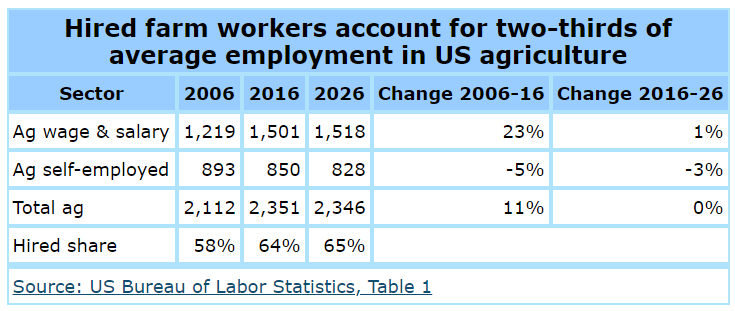
The most comprehensive data on workers employed by commodity is from the Quarterly Census of Employment and Wages that are collected from employers who pay the taxes that provide unemployment insurance benefits to laid-off workers. Employers report all of their employees who are on the payroll for the period that includes the 12th of the month, and all of the wages paid to all of the workers they employed, including those employed in other payroll periods or weeks of the month. The QCEW date are a measure of average employment or year-round equivalent jobs, not the number of unique farm workers
Some 104,445 US agricultural employers (NAICS 11) paid $43.5 billion to an average 1.3 million workers in 2017, up from 95,346 US agricultural employers who paid $30.4 billion to an average 1.2 million workers in 2008. The QCEW data exclude workers who are employed on smaller farms and H-2A workers in some states, making total average agricultural employment about 1.5 million.
California has universal UI coverage, so its QCEW data include all workers employed for wages on the state’s farms, including unauthorized and H-2A workers. In 2017, some 16,252 California agricultural employers (NAICS 11) paid $14 billion to an average 422,000 workers. All Social Security Numbers reported by California agricultural employers are farm workers and those with more than one job can be assigned to the primary NAICS or commodity where they had their highest earnings. In 2016, there were a million California farm workers, including 804,000 primary farm workers who had their highest earnings with an agricultural employer.
The number of farm workers exceeds average agricultural employment due to seasonality and turnover. There is an important difference between what a full-time farm worker would earn and what primary farm workers actually earn.
For example, all workers with at least one job in California agriculture earned 50 percent of what a full-time worker would have earned in 2016. The largest sector of employment, 115115 farm labor contractors, had the largest gap between what a full-time worker would earn, which would have been $24,600, and what workers whose highest earnings with FLCs actually earned, $9,000.
Primary farm workers earned less than a full-time worker would have earned in 2016
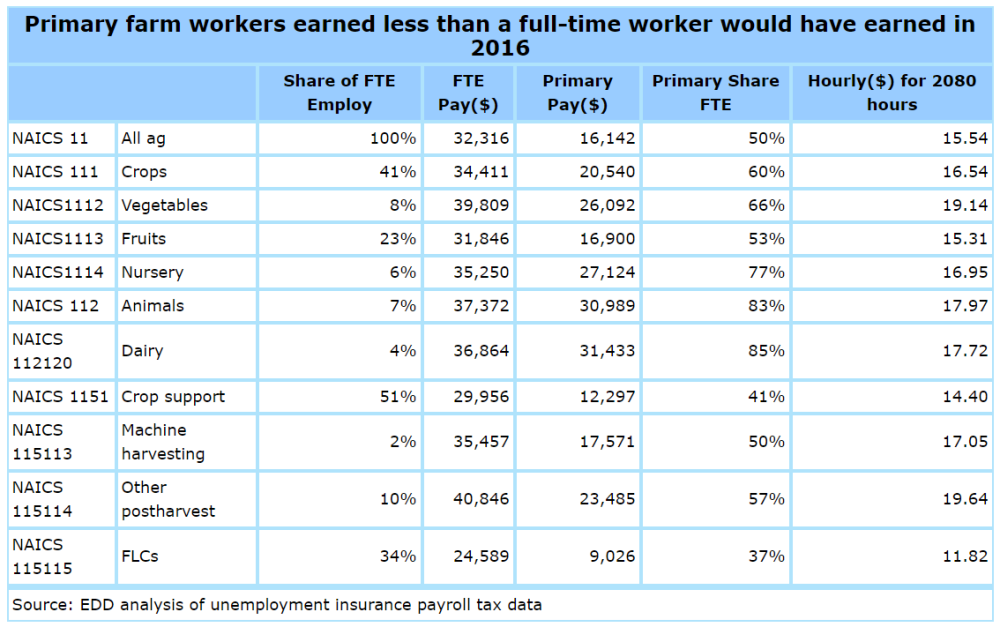
If the California ratio of two primary workers for each average employment full-time equivalent job is applied to US agriculture, there would be over three million hired farm workers. However, the number of US farm workers is likely closer to 2.5 million. First, the Hired Farm Work Force surveys in the 1980s, when average employment was at similar levels, found 2.5 million unique farm workers. Second, US agriculture is a 50-50 industry, with half of sales from crops and half from animal commodities, while California agriculture is 85-15, with 85 percent of farm sales from crops that offer more seasonal jobs than animal agriculture.
Farm Workers. The major source of data on the characteristics of farm workers is the NAWS, which covers non-H-2A guest workers who are employed in crop agriculture. H-2A guest workers are younger and almost 95 percent are from Mexico and they are mostly male. There are no reliable data on livestock workers, but they tend to be older and less Hispanic than crop workers.
The NAWS has been interviewing crop workers for three decades, and many key farm worker variables peaked between 1998 and 2000 when unauthorized Mexico-US migration was highest. The NAWS defines a migrant as someone who moves at least 75 miles from a usual home to do farm work. The share of migrants rose from 40 percent in the early 1990s to 55 percent in 2000 before dropping below 20 percent recently. The share of workers who have less than a high school education peaked in 2000, as did the share employed by a labor contractor.
The share of crop workers who were migrants peaked in 2000 at 55 percent
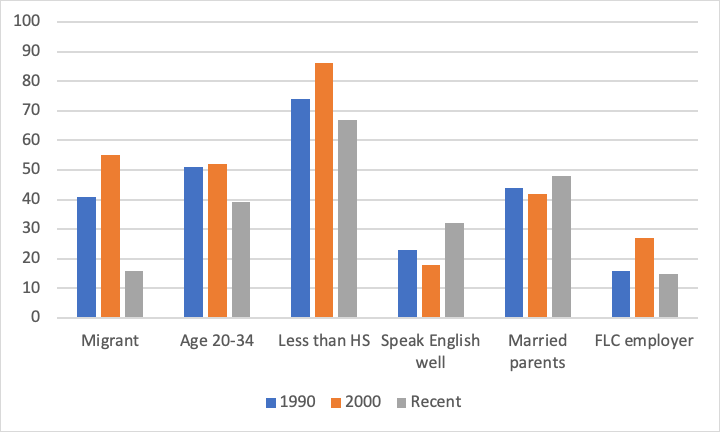
Regardless of definition, most crop workers are not migrants, and most of the migrants in the NAWS are green-card commuters, that is, Mexicans with immigrant visas who shuttle between homes in Mexico and one US farm employer. Less than a third of migrants, and less than five percent of all crop workers, are follow-the-crop migrants who have at least two US farm employers at least 75 miles apart. However, some farm workers are employed by labor contractors who move workers from farm to farm, so some workers may commute an hour or more a day to jobs on multiple farms.
The NAWS portrays an aging and settled workforce that lives in rented housing away from the one farm where the worker is employed. Farm work for most workers is like nonfarm work: drive or car pool to work and, at the end of the day, return to a nonfarm residence away from the workplace.
Adjustments. The share of labor employed in agriculture falls as per capita incomes rise in all societies, as farmers and farm workers are pushed by low incomes and wages, and pulled by higher wages and benefits, into nonfarm jobs. Rising farm wages speed up the farm-to-nonfarm transition by inducing the agricultural supply chain from equipment manufacturers to food processors to cooperate with farmers to make labor-saving adjustments.
There are three major labor adjustments to rising labor costs. Labor-saving mechanization can transform a labor-intensive commodity into a capital-intensive commodity. Mechanizing hand tasks in agriculture requires a systems perspective, cooperation between biology and engineering, and trial-and-error innovation, as illustrated by the mechanization of the processing tomato harvest as the Bracero program ended in the early 1960s.
Instead of growing a few acres of tomatoes alongside other commodities, fewer and larger farmers expanded their tomato acreage to justify purchasing mechanical harvesters and trucks to convey harvested tomatoes to processing plants, which adapted to receiving 25-ton truck loads of tomatoes rather than 50-to 60-pound lugs. Plant scientists developed uniformly ripening tomatoes, and engineers designed a machine to cut the plant and shake tomatoes from the vines.
The first harvesting machines could not separate tomatoes from dirt and leaves efficiently, so ride-along sorters were required until cutting and shaking systems were improved and electronic eyes separated tomatoes from debris. Contemporary predictions that farmers would have to follow their workers to Mexico were wrong, as the hours of labor necessary to harvest a ton of tomatoes fell and California’s production of tomatoes rose from a million tons with Braceros to 10 million tons with machines (the processing tomato harvest is expected to be 12 million tons in 2020).
Tomato harvest mechanization reduced labor needs and led to increased production
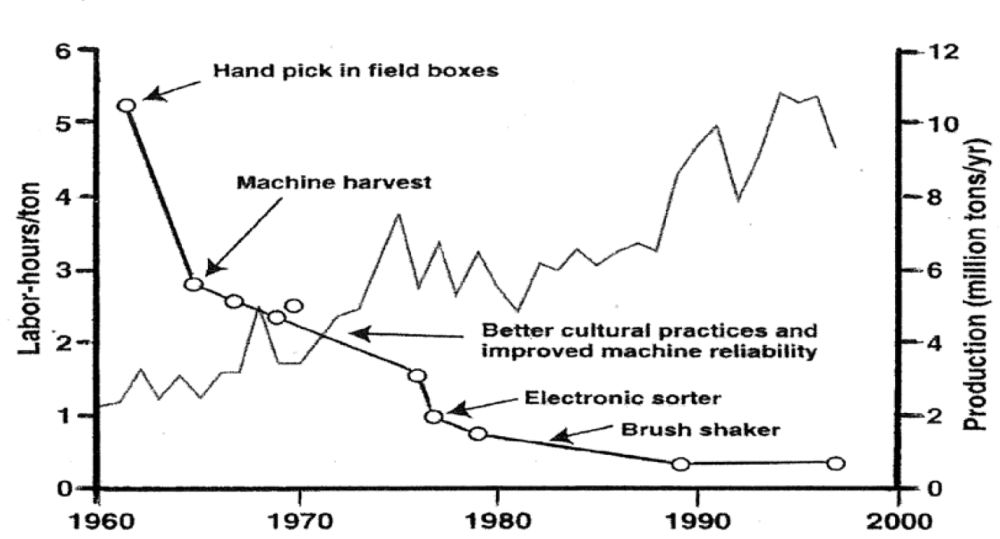
Instead of mechanization, there could be more guest workers. The number of US farm jobs certified to be filled with H-2A workers remained below 100,000 until 2014, doubled to over 200,000 in 2017, and has continued to increase. H-2A guest workers now fill 10 percent of the seasonal jobs in US crop agriculture, while Braceros at their peak in the mid-1950s filled 20 percent of the jobs in US agriculture.
The number of farm jobs certified to be filled by H-2A workers doubled between FY14 and FY17.
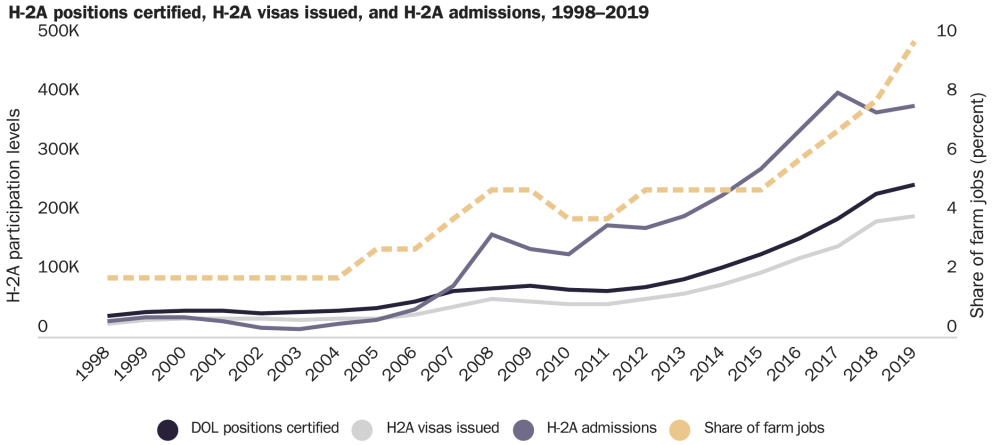
Note—DHS admissions data count each admission of an H-2A holder, so that each entry of an H-2A worker who elects to live in Mexico and commute daily to US farm jobs in border areas is counted. Admissions are NOT a count of unique workers.
The third adjustment would be to import more labor-intensive fresh fruits and vegetables. Half of the fresh fruit consumed in the US, and a third of the fresh vegetables, are imported. Mexico is the source of half of US fresh fruit imports, led by avocados, and three fourths of the fresh vegetable imports, led by tomatoes. The US imported FVH commodities worth an average $15 billion a year from Mexico in recent years.
Mexico is the major source of fresh fruit and vegetable imports for US consumers
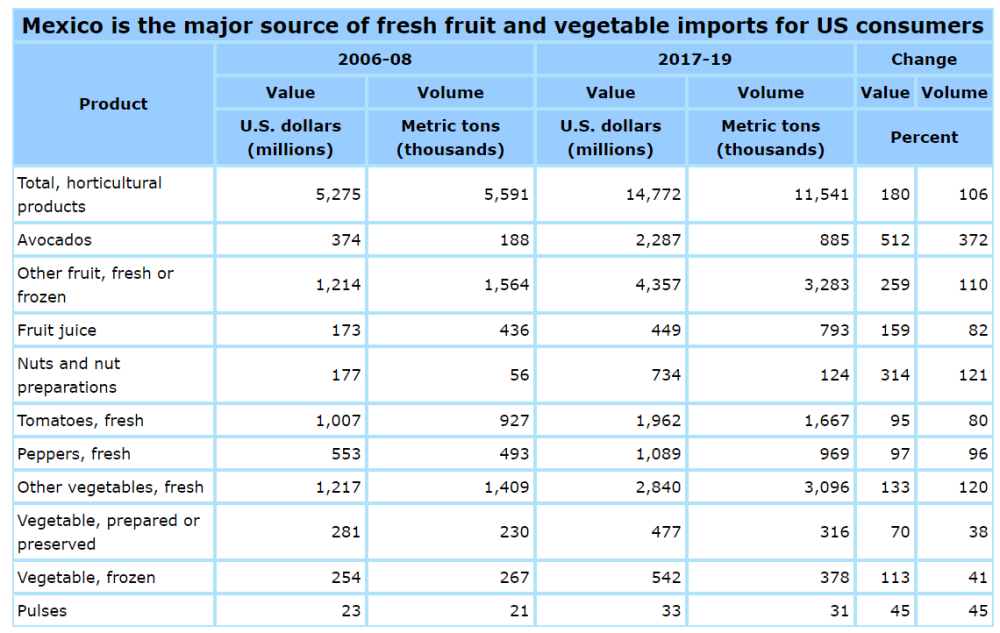
Author


Mexico Institute
The Mexico Institute seeks to improve understanding, communication, and cooperation between Mexico and the United States by promoting original research, encouraging public discussion, and proposing policy options for enhancing the bilateral relationship. A binational Advisory Board, chaired by Luis Téllez and Earl Anthony Wayne, oversees the work of the Mexico Institute. Read more

Explore More
Browse Insights & Analysis
Understanding Trade Promotion Authority (TPA): Implications for US Trade

The Innovative Landscape of African Sovereign Wealth Funds

